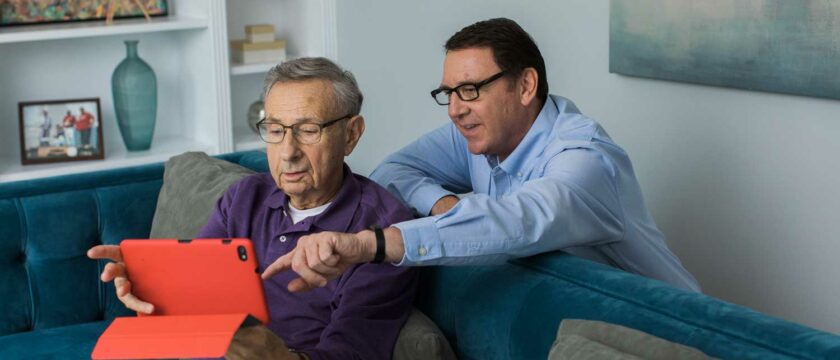Modern technology and apps for older people, especially those living home alone, are more high-tech than you may think.
In simple terms, one does not usually equate modern technology with older people. Smartphones, computers, or other trendy electronic gadgets can be navigated by younger generations in their sleep. But they may be a bit more complicated or of no interest to older generations. However, modern tech as it applies to older people, especially those living alone, is more high-tech than you may think.
The goal for many older people is to live independently in their own homes for as long as possible. However, for some, doing so can be challenging due to physical or mental limitations. Sometimes older people need help that is not readily available in human form. This is where technology enters the elderly world, offering a plethora of aids that assist older people with daily living.
Pill boxes are available that beep reminder messages at appropriate times and even dispense proper medication dosages. Mats with electronic sensors can be placed at the sides of beds. These send electronic alerts if older people fall out of bed in the middle of the night. Tabletop consoles, necklaces and other pendants with panic buttons to alert help are readily available for older people to use in other times of need. Portable GPS systems are popular to help keep track of those who often wander or get lost.
But, technology for older people does not stop there. While many people think of apps as things that younger people use, there are actually several apps that are ideal for older people, as well as for caregivers of older people. After all, there are all kinds of older people who are very tech-savvy and are using computers and mobile devices every day.
Why not have apps that are specifically targeted towards them? These are not just apps for bingo (although you can find bingo apps) and keeping touch with the grandkids. These apps range from health care to fun and games, and many are inexpensive or even free. Here are some of the best apps and tools for older people and anyone who is a caregiver.
Apple Operating System (iOS)
The Apple iOS (currently Version 10) is the Operating System used for Apple iPad tablets, iPhone smartphones and the iPod touch. This operating system has a number of integrated functions that allow or improve access for people with disabilities. Older versions of the phone may run on older versions of the operating system so may not have all the features listed here. To access most accessibility options in your iPhone, go to Settings-General-Accessibility.
- VoiceOver:is a built-in screen reader that allows you to use the iPhone even if you can’t see the screen. You touch the screen to hear a description of the item under your finger, so, for example, it will announce battery level, whose calling or which app your fingers on. You then double-tap to activate the feature you need. When you are typing a note, email, or text message, VoiceOver echoes each character on the keyboard as you touch it, and again to confirm when you enter it. It can also speak each completed word if required. VoiceOver also includes a Braille keyboard, enabling direct braille entry.
- Zoom: lets you magnify the entire screen of any application you are using to help you see what is on the display. Double-tap on the screen to enable Zoom, then you can adjust the magnification from 100% to 1,500%.
- Siri: allows you to perform tasks on your phone hands-free using just your voice. You can send messages, schedule meetings, make phone calls, and more. This voice recognition functionality can be useful for people with a visual impairment or people with limited dexterity. Siri is also integrated with VoiceOver so you can ask Siri a question and hear the answer read out loud.
- Speak Screen: reads the contents of a page back to you, for example, you can use Speak Screen to read out your email, iMessages, webpages, and books. This may be helpful if you have a hard time reading the text on your device.
- Dictation:is a speech-to-text feature that allows you to speak what you want typed. To access Dictation, tap the microphone button on the keyboard, say what you want to write, and your device converts your words into text.
- Face Time:provides video calling, which allows people to see the caller on their screen in real-time. This can be helpful for people using sign language or lip reading.
- Font Adjustments: allows you to convert the text to a larger size so it is easier to read. You can also to bold text to make it heavier and easier to see.
- Invert Colors and Grayscale: provides higher contrast or reduces colour to help you see what’s on screen. You can save your preferred settings so that each of the phone’s features and apps use your settings.
- Visible and Vibrating Alerts: provides alternative visual and vibrating alerts for incoming phone calls, new text messages, new and sent mail, and calendar events. You can set an LED light flash for incoming calls and alerts or have incoming calls display a photo of the caller. You can also choose from different vibration patterns or create your own. This can be useful for someone with a hearing impairment.
- Mono Audio: allows you to play both audio channels (left and right) in both ears when using headphones. This means that you don’t miss any audio if you’re deaf or hard of hearing in one ear.
- Closed Captions: allows you to watch movies, TV shows, and podcasts with closed captions. You can customise captions with different styles and fonts.
- Switch Control: allows you to navigate your mobile device using a variety of Bluetooth-enabled switches.
- Guided Access: allows you to disable the ‘home’ button and restrict access to the keyboard or touch input on your mobile device so the user stays focused on one app. It also allows you to limit the amount of time spent in an app. This may help people with attention and sensory challenges to stay focused on one task.
Apple has been the pioneer in accessibility for smartphones and tablet. However, some of the Android operating systems have started to catch up. Below find details of some of their accessibility functionality.
Android Operating System (Android)
The Android operating system developed by Google is used on a range of different devices. This includes smartphones and tablet PC’s from Samsung, Acer, LG, HTC, Motorola, Sony Ericsson, etc. Therefore it does not have as many integrated accessibility features and not all phones using the Android operating system will have all the accessibility features listed below.
If your phone does not have any of these features, you can download them for free in the Android App Store.
To access most accessibility options in your Android phone, go to Settings > Accessibility.
Some of these accessibility apps are not compatible with older devices working on an older version of the Android operating system.
- Talkback: is a screen reader that provides spoken and vibration feedback to describe your actions on the phone or Tablet, such as when you launch an app, add an event or make and receive calls, etc. Soundback, Kickback and Explore by Touch are included in Talkback for devices using Android 4.0 or higher or for older devices are featured separately in the device’s accessibility section. Soundback lets you assign sounds to alert you to actions on your phone, Kickback provides vibration feedback when you perform actions on your phone and Explore by Touch uses speech to describe each item that your finger moves over on the screen.
- Voice Access: lets you control your Android device with your voice. Using spoken commands, you can activate on-screen controls, launch apps, navigate your device and edit the text using your voice rather than touching the screen. This feature requires Android 5.0 or higher to run.
- BrailleBack: allows you to connect a refreshable braille display to your Android device (via Bluetooth) so screen content appears on your braille display. Then you can navigate and interact with your device using the keys on the braille display. You can also input text using the braille keyboard. BrailleBack works with the TalkBack screen reader service to provide a combined speech and braille experience.
- Switch Access: lets you interact with your Android device using one or more switches. This can be helpful for users with mobility limitations that prevent them from interacting directly with the Android device. This feature only applies to devices running Android 5.0 and higher.
- Captions: allows you to turn on closed captioning for some functionality on your phone. This feature may allow you to see the words in text as they are being spoken in certain apps. You can set the language, text, and style for the closed captioning to suit your needs. Requires Android 4.4 and higher to run.
- Magnification Gestures: allows you to temporarily magnify the screen of your device. When magnification gestures are enabled, you can magnify, pan, and zoom in using a range of different gestures.
- Large Textincreases the text size on your device to the largest available size.
- High Contrast Text fixes the text colour as either black or white making text easier to read on your device. This feature runs on Android 5.0 and higher.
Comfort Keepers continues to research and develop cutting edge technology to ensure the safety of the independent older people living home alone.
Connect with us
To begin starting care for your loved one, you can click here.
To join our incredible award-winning team, you can apply now by clicking here or emailing your CV to recruitment@comfortkeepers.ie





